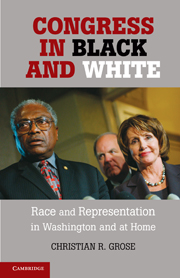Book contents
- Frontmatter
- Contents
- List of Figures and Tables
- Acknowledgments
- 1 African-American Legislators, African-American Districts, or Democrats?
- 2 A Unified Theory of African-American Representation in Congress
- 3 The “Hollow Hope” of Civil Rights Change in the U.S. House
- 4 Location, Location, Location
- 5 Constituency Service in the District
- 6 Bringing Home the Bacon
- 7 The Future of Racial Redistricting
- Appendix 1 Methods Used to Measure the Civil Rights Issue Space
- Appendix 2 Methods for Qualitative Research
- Appendix 3 Data, Methods, and Models for Project Allocations to African Americans
- References
- Index
1 - African-American Legislators, African-American Districts, or Democrats?
Published online by Cambridge University Press: 03 May 2011
- Frontmatter
- Contents
- List of Figures and Tables
- Acknowledgments
- 1 African-American Legislators, African-American Districts, or Democrats?
- 2 A Unified Theory of African-American Representation in Congress
- 3 The “Hollow Hope” of Civil Rights Change in the U.S. House
- 4 Location, Location, Location
- 5 Constituency Service in the District
- 6 Bringing Home the Bacon
- 7 The Future of Racial Redistricting
- Appendix 1 Methods Used to Measure the Civil Rights Issue Space
- Appendix 2 Methods for Qualitative Research
- Appendix 3 Data, Methods, and Models for Project Allocations to African Americans
- References
- Index
Summary
In November 2008, then-Senator Barack Obama surprised the nation and the world by becoming the first African-American president of the United States. In a country where nearly all major elected officials are white, Obama had pulled off what seemed impossible to many. Not only had no African American ever won the presidency, in a country whose voting majority is white, but very few African Americans had ever been elected to any federal office in constituencies where black voters did not constitute a majority. Prior to the 2008 elections, for instance, only three African Americans had ever been elected to the U.S. Senate since Reconstruction (one of whom was Obama, representing Illinois from 2004 to 2008). Dianne Pinderhughes (2009, 4), reflecting on Obama's historic electoral triumph, noted that a “number of the most high achieving, successful African Americans, whether in academic, literary or political life thought it improbable that there would ever be a president of African American ancestry.”
In the U.S. House of Representatives, cracks in the racial glass ceiling had become apparent a decade before Obama won the presidency. Until the mid-1990s, nearly all African Americans elected to the U.S. House won election from districts without white majorities. However, beginning in 1996, a few black legislators – in southern states that had only decades earlier employed Jim Crow laws to disfranchise African Americans – won election to Congress in districts in which whites were a majority.
- Type
- Chapter
- Information
- Congress in Black and WhiteRace and Representation in Washington and at Home, pp. 1 - 13Publisher: Cambridge University PressPrint publication year: 2011



